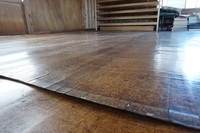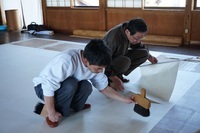

Total:131items
- Pottery & Porcelain (18)
- Lacquerware (4)
- Glasswork (2)
- Wood & Bamboo Work (19)
- Leather Work (1)
- Papermaking (13)
- Textile (20)
- Dyeing products (5)
- Masonry (1)
- Metal Work (11)
- Stationery (4)
- Accessory (4)
- Livingware (3)
- Toys & Entertainment (14)
- Interior (2)
- Other crafts (10)
- Osaka Shamisen (Japanese three-stringed guitar)
- Kyo-Hanga: Kyoto woodblock print
- Hyuga Kendo Armor
- Kanazawa-Haku: Kanazawa Gold Leaf
- Simotsuke-Suisha: Simotsuke Waterwheel
- Koshigaya-Katchu: Japanese traditional armor
- Ise netsuke : Ise miniature wooden sculpture
- Yuton: Lacquered Paper Mat
- Iwami Kagura Mask
- Oroku-gushi: Oroku-gushi Combs

 |
Main Production Site:Fukui |
 《Characteristics》
《Characteristics》Yuton, which is composed of thick-layered washi (Japanese traditional hand-made paper), is a lacquered paper mat for summer. It is characterized by its dark brown with color as well as comfort from cool sensation it provides when sitting down on it. Its surface is so shiny and smooth that it even mirrors the shades of pillars, as the Japanese famous Haiku poet TAKAHAMA Kyoshi composed:
Shiny surface of Yuton
Even reflects
Pillars inside a house
Yuton is a summer kigo (word or phrase indicating particular season in Haiku poem) because of its association with summer.
Craftsmen dedicate great deal of time and effort to yuton production that requires large quantities of washi. Types of washi that are mainly used for crafting yuton are Mino-gami (paper made in Mino City, Gifu Pref., central Japan), kasa-gami (paper for umbrellas) andchōchin-gami (paper for lanterns). With the right care and maintenance including repair, yuton could last for more than 100 years. One of the repair methods is, cutting severely damaged parts off so that the rest could still be used as reduced-size yuton. The other is, tearing damaged parts off to fill and paste the part with a piece from another yuton. Even if liquid drops on the mat, stains cannot be left if it is wiped out immediately.
Yuton used to be utilized as a way to ward off heat during summer in the days without various kinds of electric cooling devices we enjoy in the age of convenience. Craftsmen apply egoma-abura (perilla oil) that could penetrate only the surface of yuton, making plastic-like upper layer. The number of cavity kept in the lowest layer is larger than that of the middle layer as the amount of egoma-abura penetrating through the washi layers decreases. Such structure allows yuton to have the heat insulating effect. Unlike plastic which tends to get warm easily, yuton keeps drawing heat from human bodies for even an extended time. It achieves long-lasting comfort of fresh and cool feeling when sitting down on it during hot summer. Being made with natural materials, yuton could be called eco-friendly and natural air conditioner for summer.
[Fukui prefectural intangible folk cultural property]
Information provided by Beniya Koyodo
Image provided by Business Support Division of Sabae Chamber of Commerce
Translation by: Asuka Ikenouchi

| Materials | Washi, egoma-abura (perilla oil), Shibu (tannin), Kaki (persimmon), nori (glue) and others |
|---|---|
| Crafting Processes | 【1】 Hyoshi-Saidan and Hariage; Starting of washi pasting
The sheets of washi are glued together horizontally and vertically. After the glue used for setting yuton-dai* dries up (*the yuton-crafting board made of persimmon tannin juice-coated washi. Edges of the coated washi are glued to the floor by utilizing the method called fukuro-bari that applies glue only along the edges of paper to create something like a bag or fukuro in Japanese), the washi papers are laid face down on it. These washi papers have about 1-sun (about 30mm) overlap to be glued together. Then 100% pure kozo washi (paper made of mulberry), are then pasted on them. 【2】 Urauchi; Forming of layers The washi papers should be overlapped by 1-bu (about 3mm) to be glued together, leading to one large piece of washi with the size exactly covering the required size of jo; Japanese unit for the size of room measured by the number of Tatami mat (1.5-1.8m2). If the size required is 6-jo or 6 tatami mats (one of the common Japanese room sizes, 9-11m2), the process to make 1-bu overlap should continue until the enlarged sheet reaches the size of 6-jo. The enlarged sheet of washi are repeatedly put on top of one another. At this stage of process 2, craftsmen add and glue 3 layers, taking into account short grain. Direction of fibers of washi needs to run parallel to the short side of yuton as it should be rolled up to be stored in a storehouse or the like when not in use; yuton is rolled up with its surface facing inward while fibers of washi running vertically to the direction of rolling. 【3】 Sumiuchi; Drawing of chalk lines The lines, as indicators of finishing size, are drawn by using sumitsubo (chalk box). 【4】 Urauchi; Addition of more sheets of washi to make yuton sturdier and more durable The first layer formed in this process 4 is built by sheets of washi with each weighing 5 to 6-monme (Japanese traditional unit to measure thickness of washi. 1-monme is about 4 g). Such washi sheets are laid side by side and pasted together within sumiuchi lines. Each short-grain washi with a weight of 5 to 8-monme is pasted side by side to form the second layer of this process 4. And then 6 alternating layers of thick long-grain washi and thin short-grain washi should be formed. The sheets of short-grain washi are once again used to build up the last 3 layers of this process 4. Thirteen to 15 layers are eventually formed to make yuton approximately 4 mm thick. Wheat starch is used to paste each washi paper with attention to reduce wrinkles. The washi papers are beaten by uchi-bake (thick beating brush) to have fibers of washi entwine with each other. Dust on or buried in the washi is scraped off with a knife prior to addition of another layer. 【5】 Mimi-mage (literally: ear folding): Folding of edges After the glue dries out, separate yuton from yuton-dai by using takehera (spatula made of bamboo). The mat is cut with a margin of 1-bu 3-sun (1-sun is 30.3 mm and 1-bu is 3.03 mm) from the sumiuchi line. The margin needs to be folded behind and the folds are pressed hard to reinforce edges of yuton. In order to prevent the folds from coming off as well as to lay groundwork for the next step, washi overlapping mimi-mage by 5-bu while running off by about 1-sun 5-bu is glued to the yuton-dai. For the same purpose, technique which is to cover the entire backside of yuton with 1 large sheet of washi could be employed by craftsmen in some cases. 【6】 Shibu-hiki; Kaki-shibu (persimmon tannin juice) coating The yuton is glued to the yuton-dai and then traditional Japanese lacquer of kaki-shibu is applied to the backside of yuton in order to make it waterproof and bug proof and to prevent scuffing. There are two ways of kaki-shibu coating; either misting (of kaki-shibu) from mouth or gentle rubbing with kaki-shibu soaked soft cloth. 【7】 Mimi-sogi; Cutting of extra part The yuton is separated from the yuton-dai by using takehera and nori-shiro (area left for putting glue) is cut off with a knife. 【8】 Abura-hiki; Oil coating The coating process to apply egoma-abura on the front side of yuton with oil-soaked cloth is repeated twice. The second round is carried out immediately after the first round completes. 【9】 Tenpi (Sunlight)-boshi (drying); Sun drying of yuton The yuton is left untouched overnight in order for oil to infiltrate well after the process 8 finishes, and on the very next day, the mat is carried to the roof exclusively for the process to lay and dry yuton up in the sun. 【10】 Nekashi; Letting the yuton rest The yuton is left untouched overnight in order for oil to infiltrate well after The yuton should be left face up for about a month so that oil penetrate deeper into layers of washi. 【11】 Tsuya-dashi; Polishing The surface of yuton is polished as the last step for yuton crafting after process 10; drying up of yuton. Shortly after the surface of yuton is rubbed with cotton cloth wrapping mashed tofu, it is againpolished up with dried cloth until it gleams. |
| History | The origin of yuton has not been clear but there is one story from the area of Daian-ji Templein Fukui prefecture, central Japan. According to the story, Shika-mura Village in that area had limited rice fields because of topographic constraints. This made the life of the villagers hard especially when a flood damage caused by heavy rainfall resulted in a rice yield scarcity.
Given such a harsh condition of people, Daido-osho (the chief priest of a Buddhist temple) suggested people in the area produce hand-made papers as a mean, even if only slightly, to complement their livelihood. This area was fortunate enough to have many mountain streams as well as spring water against the backdrop of mountains. Abundant source of clear spring water is necessary for producing Japanese paper,washi. Therefore, it could not be coincidence that Shika-mura became active area of crafting yuton out of washi. It is said that booming economy during the period of Showa 30 to 40 (1955 to 1965) generated high demand for yuton and that quite a few shops among more than 100 Hyogu-ya(s) (shop(s) of scroll mounting) in Fukui prefecture actually produced yuton at that time. Unfortunately, there is only 1 studio left that produces yuton because of the penetration of electric appliances as well as the considerable time and effort required to produce yuton (The production of 6-jo size yuton requires at least one month of work by 3 craftsmen). Despite this situation, the traditional yuton production technique is still cherished to pass it down to the next generation. |
◆Exhibition / Showcase
Beniya-Kouyou-Dou
2-10 Tamura-cho, Sabae-city, Fukui prefecture 916-0087
TEL : +81-778-62-1126
◆Event Information
Assistance needed? For inquiries in English:
JTCO Contact Form
Your inquiries will be forwarded by JTCO in Japanese to the organization you wish to contact.
*Please write the name of craft you wish to ask about.



